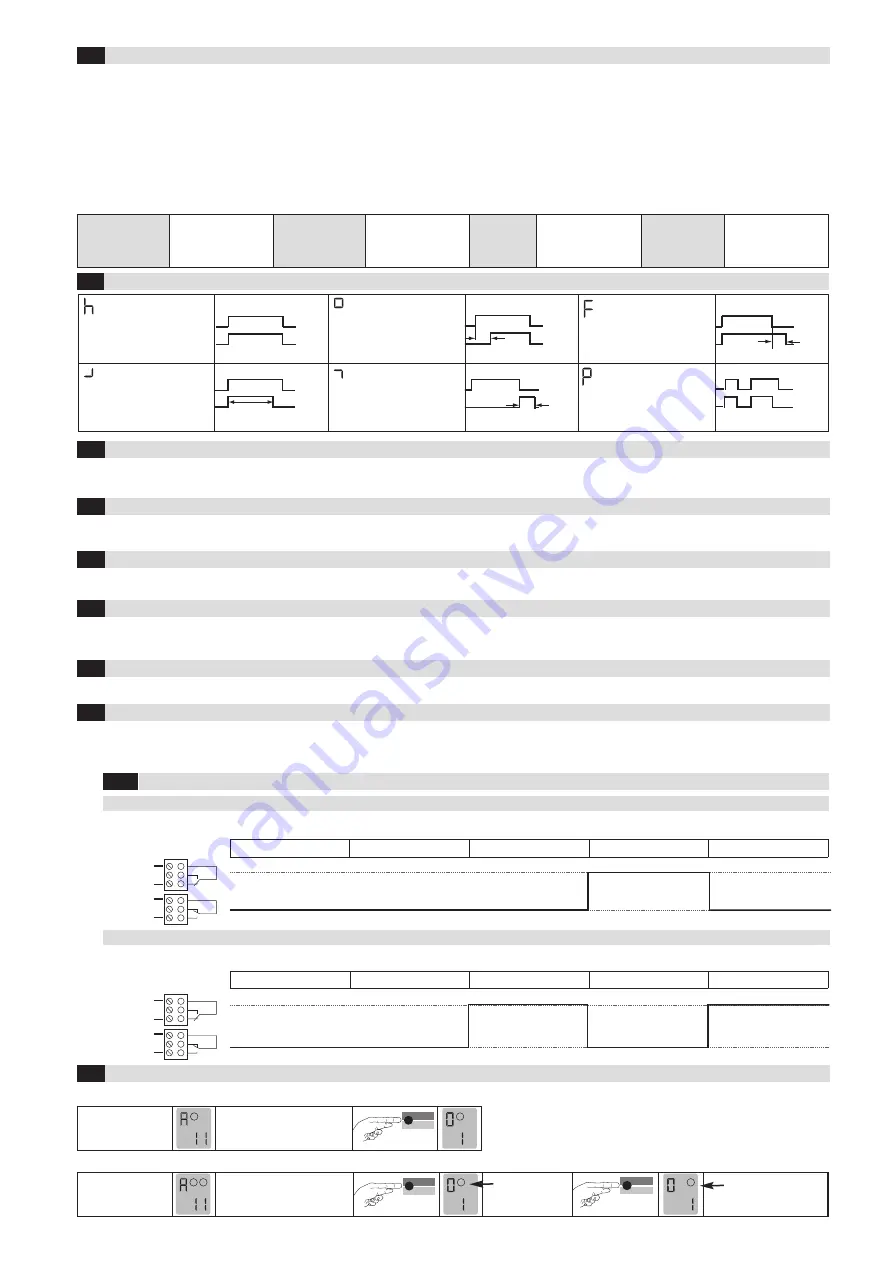
2
Relay response to malfunctions (see chapter 6 Troubleshooting):
The relay picks up when the
loop is activated and drops
out when the loop is exited.
Loop
Relay
On delay:
The relay picks up after the
time t when the loop is acti-
vated and drops out when
the loop is exited.
Loop
Relay
tt
Off delay:
The relay picks up when the
loop is activated and drops
out after the time t when the
loop is exited.
Loop
Relay
tt
Activation pulse:
The relay picks up when the
loop is activated and drops
out again after the time t.
Loop
Relay
tt
Impulse by leaving the loop:
By leaving the loop,
the relay picks up after
the time t, relay drops out.
Loop
Relay
tt
Max. presence:
he relay picks up when the
loop is activated and drops
out again after leaving, but
at least after the time t.
Loop
Relay
tt
1.Door/gate
systems
A malfunction causes
the output relay to be
released. The alarm
relay drops out.
2. Barrier
A malfunction causes
the output relay to pick
up. The alarm relay
drops out.
3. Quiescent
current
A malfunction causes
the output relay to be
released. The alarm
relay drops out.
4. Direction logic
(2-loop device
only)
A malfunction causes
the output relays to be
released. The alarm
relay drops out.
*factory settings
Note: The set parameter values are retained after a power failure, independent from the “Protection against power failure” function.
P 1
= Protection against power failure activated: The sensitivity is restricted to 1–5.
Time functions
1
, time unit
2
and time factor
3
(Einstellungen siehe Tabelle 4.11a)
4.3
Parameters
1: Door and gate
The assigned output relay picks up when the loop is activated and drops out when the loop returns to a non-activated condition.
2: Barrier
The assigned output relay picks up when the loop is activated and drops out when the loop returns to a non-activated condition.
3: Quiescent current
The assigned output relay drops out when the loop is activated and picks up again when the loop returns to a non-activated condition.
4: Direction logic
Output 1 switches if an object moves from loop 1 to 2. Output 2 switches if an object moves from loop 2 to 1.
Both loops
must be
activated for a short time. The outputs are reset again when loop 2 returns to a non-activated condition. Both loops must have re-
turned to a non-activated condition for another direction detection.
0: Loop 2
Loop 2 can be deactivated in a 2-loop device.
Basic functions
0
(see Table 4.11a for settings)
4.2
Signal characteristics with protection against power failure active (Function 9 = 1)
4 .9.1
For Activation (e.g. Barriers)
Basic function 0 =
2 Barrier systems
Without power
Initialisation
Free
Occupied
Free
For Safeguarding (e.g. Barriers, bollards)
Basic function 0 =
3 Quiescent current
Without power
Initialisation
Free
Occupied
Free
Output
Output
The sensitivity
5
(=Sensitivity) of the loop detector can be adapted in 9 stages:
51 =
Lowest sensitivity,
59 =
Highest sensitivity,
54 =
Factory setting.
In a device with 2 outputs, output 2 can be either activated or deactivated.
Four different frequencies F1, F2, F3, F4* can be set in order to avoid interference when using several loop detectors.
The direction logic function can only be used with a 2-loop device. Direction logic must have been set in the basic function (see chapter 4.2). Detection
can be performed from:
➝
Loop 1 to loop 2
➝
From loop 2 to loop 1
➝
from both directions
ASB (=
A
utomatic
S
ensitivity
B
oost). ASB is required in order to be able to recognise trailer drawbars after activation.
Sensitivity 4 (see Table 4.11a for settings)
4.4
Automatic Sensitivity Boost ASB
5
(see Table 4.11a for settings)
4.5
Frequency
6
(see Table 4.11a for settings)
4.6
Direction logic
7
(see Table 4.11a for settings)
4.7
Output 2
8
(see Table 4.11b for settings)
4.8
Protection against power failure
9
(see Table 4.11a for settings)
4.9
Display after start-up:
1
Touch the «Mode» button once
to change to configuration
mode
Mode
Sim1
1
Display after start-up:
1
2
Touch the «Mode» button once
to change to configuration
mode
Mode
Sim1
1
Mode
Sim1
2
Loop 2 is
selected
Loop 1 is
selected
1- loop device
2- loop device
Changeover from operation to configuration mode
4.10
common
nc
no
common
nc
no
common
nc
no
common
nc
no






















